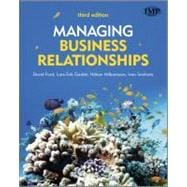
| About the Authors | p. ix |
| Preface | p. xi |
| The Importance of Business Relationships | p. 1 |
| The reality of business relationships | p. 1 |
| Markets, marketing and purchasing management | p. 6 |
| The substance of business relationships | p. 10 |
| Managing business relationships for customers and suppliers | p. 10 |
| References | p. 12 |
| What are Business Relationships All About? | p. 14 |
| Introduction | p. 14 |
| Interaction and relationships | p. 15 |
| Time and the business relationship | p. 17 |
| The substance of a relationship | p. 18 |
| The first facet of a relationship: the relationship as a device | p. 21 |
| The second facet of relationships: relationships as assets | p. 29 |
| The third facet of relationships: relationships as problems | p. 38 |
| Conclusions | p. 40 |
| References | p. 41 |
| Relationships with Customers | p. 42 |
| Introduction: the complexity of customer relationships | p. 42 |
| The characteristics of customer relationships | p. 45 |
| Managing continuing customer relationships | p. 51 |
| Developing customer relationships | p. 53 |
| Managing a relationship with a single customer | p. 56 |
| Managing a portfolio of customer relationships | p. 64 |
| Conclusions: managing relationships with customers | p. 69 |
| Relationships with Suppliers | p. 73 |
| The significance of suppliers | p. 73 |
| What suppliers can do for a company | p. 75 |
| Key features of supplier relationships | p. 78 |
| Managing the supplier base: a networking issue | p. 86 |
| Managerial issues in networking with suppliers | p. 90 |
| Conclusions: making the most of supplier relationships | p. 96 |
| References | p. 97 |
| The Economics of Business Relationships | p. 99 |
| Introduction: the economic problems of business relationships | p. 99 |
| The idea of relationship value | p. 102 |
| The elements of relationship value | p. 103 |
| Costs of business relationships | p. 105 |
| Benefits from business relationships | p. 109 |
| Analysing relationship benefits | p. 112 |
| Relationship value and price | p. 113 |
| Pricing approaches in business relationships | p. 117 |
| Conclusion | p. 124 |
| References | p. 125 |
| Intermediation in Business Relationships | p. 126 |
| Introduction | p. 126 |
| The role of intermediation | p. 127 |
| Intermediation from a network perspective | p. 129 |
| Intermediation and distribution | p. 132 |
| Intermediation from the perspective of the end-user | p. 134 |
| Intermediation from the perspective of the supplier | p. 139 |
| Conclusions | p. 151 |
| References | p. 153 |
| Technology and Business Networks | p. 155 |
| Introduction | p. 155 |
| The range of technologies | p. 157 |
| Assessing the potential value of technology in business networks | p. 160 |
| A network view of technological development | p. 162 |
| Embedded and technological development | p. 165 |
| Relationships and technological development | p. 168 |
| Creating economic value from technology | p. 174 |
| Conclusions | p. 176 |
| References | p. 177 |
| Managing in Networks | p. 178 |
| Introduction: managing business relationships in the network economy | p. 178 |
| What is a network? | p. 182 |
| Managerial questions about operating in networks | p. 184 |
| Analysing network choices | p. 193 |
| Conclusions: strategy in networks | p. 205 |
| References | p. 206 |
| Developing the Practice of Business Networking | p. 209 |
| Introduction | p. 209 |
| The process of business networking | p. 211 |
| Implementing networking | p. 217 |
| Conclusions: networking and the management of business relationships | p. 226 |
| References | p. 228 |
| Index | p. 229 |
| Table of Contents provided by Ingram. All Rights Reserved. |
The New copy of this book will include any supplemental materials advertised. Please check the title of the book to determine if it should include any access cards, study guides, lab manuals, CDs, etc.
The Used, Rental and eBook copies of this book are not guaranteed to include any supplemental materials. Typically, only the book itself is included. This is true even if the title states it includes any access cards, study guides, lab manuals, CDs, etc.